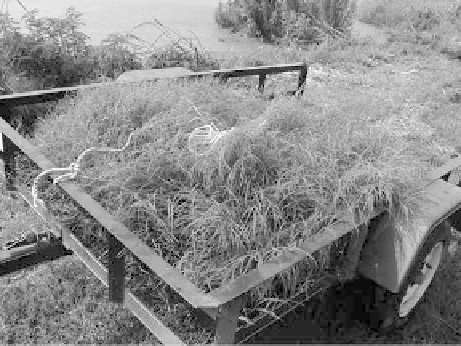Environmental Engineering Reference
In-Depth Information
Fig. 9.11
Mat with bermuda
grass being transported for
transplanting
the sod growing on and through it and then moving the mat of sod to a land site
(Fig. 9.11). The grass then grew quite well on the site to which it was transplanted.
Complete economic analyses of growing biomass for composting or bioenergy,
or grass and/or horticultural species for transplant on floating mats to improve
water quality is needed. The analyses should include both the production costs
associated with sprigging, harvesting, and transporting the material and the value
of the biomass after composting, using as a bioenergy feedstock, or transplanting.
Economic analyses also should factor in the number of farm ponds, canals, lakes,
streams, rivers, etc. which could use this technology, and the value associated with
improving water quality by removing nutrients from the water body.
9.4 Conclusions
Methods are needed to protect and improve water quality. Technologies for wastew-
ater commonly include using constructed wetlands or land application. A new
concept is to use floating vegetated mats to cover part of the surface water body.
The mats grow on floating platforms. Roots of the plants reach into the water and
take up nutrients. Biomass can be harvested from the mats or in the case of grasses
or horticultural plants, the plants can be transplanted. Harvested biomass can be
used to make compost for use as a soil amendment, or potentially for use in making
biofuel.
Both past and ongoing research has shown that floating vegetated mats can be
used to grow biomass and remove nutrients from wastewater. Completed exper-
iments on both moderately and severely contaminated swine lagoon wastewater
have shown that species can be found to grow in such waters. With the moderately
contaminated swine lagoon wastewater we were able to grow and produce cattail
and maidencane. With the severely contaminated swine lagoon wastewater we grew

